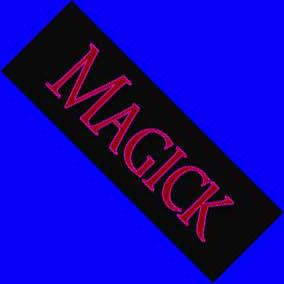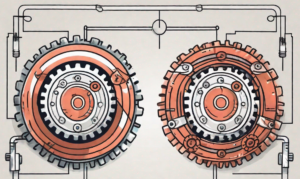Create Dynamic Images with ImageMagick
Key Takeaways
- ImageMagick is a powerful image manipulation program that allows you to create dynamic images on your website, changing properties such as size, resolution, borders, contrast, and dithering based on input from the user or the website administrator.
- To use ImageMagick’s functionality from a PHP-powered website, you need to use an API such as MagickWand or imagick. The examples in the text use the MagickWand API, which must be installed on your web server along with ImageMagick.
- With ImageMagick, you can perform a variety of operations on an image, such as cropping, scaling, trimming, converting formats, rotating, and changing the background color. After making the desired changes, you can display the finished image in the visitor’s web browser or save the new image back to disk.
Digital Image Magic
The key component for making dynamic images a reality on your site is an image manipulation program that’s controlled by the code that generates your web pages. Even though this article uses PHP as the scripting language, other languages — such as Perl and Ruby — can be used just as easily, provided that the image manipulation program that you’re considering has an application programming interface (API) for the chosen language. I’ve chosen to use ImageMagick in this article for several reasons:- it is more commonly supported by web hosting services than any other package
- it is free
- it runs on Windows and Linux platforms
- it boasts two decades of continual enhancements and bug fixing
- it is robust and powerful, offering extensive capabilities
Commands Other than “Abracadabra”
Regardless of the type of operation you want to perform on an image, first of all, you need to load that image into computer memory, and assign it to a MagickWand resource. The following PHP script loads a sample image file from the current directory, then displays it in the web browser:<?php // script_1.php
$resource = NewMagickWand();
MagickReadImage( $resource, ‘image_1.jpg’ );
header( ‘Content-Type: image/jpeg’ );
MagickEchoImageBlob( $resource );
?>
 Figure 1: The original image, displayed in the browser
Once you have created that MagickWand resource and loaded an image, you can find out information about the image, such as its dimensions:
Figure 1: The original image, displayed in the browser
Once you have created that MagickWand resource and loaded an image, you can find out information about the image, such as its dimensions:
<?php // script_2.php
$resource = NewMagickWand();
MagickReadImage( $resource, ‘image_1.jpg’ );
$width = MagickGetImageWidth( $resource );
$height = MagickGetImageHeight( $resource );
echo “Image size, in pixels, is: width $width x height $height”;
?>
<?php // script_3.php
$resource = NewMagickWand();
MagickReadImage( $resource, ‘image_1.jpg’ );
MagickCropImage( $resource, 200, 50, 0, 0 );
header( ‘Content-Type: image/jpeg’ );
MagickEchoImageBlob( $resource );
?>
 Figure 3: A cropped image
In the second case, let’s say that your application calls for the preservation of the image as a whole, but needs to scale the image down to a smaller size (such as a maximum of 200×200 pixels). The following script will resize the image:
Figure 3: A cropped image
In the second case, let’s say that your application calls for the preservation of the image as a whole, but needs to scale the image down to a smaller size (such as a maximum of 200×200 pixels). The following script will resize the image:
<?php // script_4.php
$resource = NewMagickWand();
MagickReadImage( $resource, ‘image_1.jpg’ );
$resource = MagickTransformImage( $resource, ‘0x0’, ‘200×200’ );
header( ‘Content-Type: image/jpeg’ );
MagickEchoImageBlob( $resource );
?>
 Figure 4: A scaled image
The image shown above illustrates how the
Figure 4: A scaled image
The image shown above illustrates how the MagickTransformImage function automatically preserves the image’s aspect ratio when scaling.
Also note that MagickTransformImage returns the transformed image as a new resource, which must be assigned to a variable in order to be preserved. In contrast, the previous function that we considered — MagickCropImage — acted upon the resource variable that was passed to it; it returns a boolean value (TRUE or FALSE). When writing your own MagickWand code, be sure to confirm the return type of each function, since any incorrect assumptions can result in considerable time spent debugging.
Perhaps an image has a border of 20 pixels on its left and right sides that you wish to eliminate, though you don’t want to remove any pixels from the top or bottom of the image. The following script will do just that:
<?php // script_5.php
$resource = NewMagickWand();
MagickReadImage( $resource, ‘image_1.jpg’ );
MagickShaveImage( $resource, 20, 0 );
header( ‘Content-Type: image/jpeg’ );
MagickEchoImageBlob( $resource );
?>
 Figure 5: A trimmed image
Next, let’s suppose that you have an image in PNG format, and you would like to reformat it as a JPEG image. Here’s the script that performs the conversion:
Figure 5: A trimmed image
Next, let’s suppose that you have an image in PNG format, and you would like to reformat it as a JPEG image. Here’s the script that performs the conversion:
<?php // script_6.php
$resource = NewMagickWand();
MagickReadImage( $resource, ‘image_1.png’ );
MagickSetImageFormat( $resource, ‘JPEG’ );
header( ‘Content-Type: image/jpeg’ );
MagickEchoImageBlob( $resource );
?>
 Figure 6: A JPEG image converted from PNG format
Images can also be rotated! Perhaps you’d like to rotate the above image 45 degrees in a clockwise direction? Easy!
Figure 6: A JPEG image converted from PNG format
Images can also be rotated! Perhaps you’d like to rotate the above image 45 degrees in a clockwise direction? Easy!
<?php // script_7.php
$resource = NewMagickWand();
MagickReadImage( $resource, ‘image_1.jpg’ );
MagickRotateImage( $resource, null, 45 );
header( ‘Content-Type: image/jpeg’ );
MagickEchoImageBlob( $resource );
?>
 Figure 7: A rotated image
In the above script, we didn’t specify a color to be used for any areas that were newly exposed as a result of the rotation. But we can certainly do that:
Figure 7: A rotated image
In the above script, we didn’t specify a color to be used for any areas that were newly exposed as a result of the rotation. But we can certainly do that:
<?php // script_8.php
$resource = NewMagickWand();
MagickReadImage( $resource, ‘image_1.jpg’ );
MagickRotateImage( $resource, NewPixelWand( ‘blue’ ), 45 );
header( ‘Content-Type: image/jpeg’ );
MagickEchoImageBlob( $resource );
?>
 Figure 8: Image rotated, with blue background
Figure 8: Image rotated, with blue background
Pulling the Rabbit from the Hat
After you’ve made all the desired changes to an image — or your PHP script has allowed your site visitor to do the same — you can display the finished image in your visitor’s web browser (as we’ve done above), or you can save the new image back to disk. Let’s modify our previous sample script to save the image to disk:<?php // script_9.php
set_time_limit( 60 * 5 );
$resource = NewMagickWand();
MagickReadImage( $resource, ‘image_1.jpg’ );
MagickRotateImage( $resource, NewPixelWand( ‘blue’ ), 45 );
MagickWriteImage( $resource, ‘new_image.jpg’ );
?>
You will notice an additional change here: set_time_limit sets the script timeout in seconds (in this case, to five minutes). This is a wise precaution if there’s a possibility that your script may be handling image files that are large enough to exceed the default script timeout for your web server.
Learning the Tricks
If you want to learn more about ImageMagick, the most promising resource is Michael Still’s book The Definitive Guide to ImageMagick (ISBN 1590595904), published in December 2005, by Apress. It explains how to install and configure ImageMagick for several Linux distributions as well as Microsoft Windows. The chapters cover basic image manipulation, compression, other metadata, ImageMagick tools, artistic transformations, other image transformations, and drawing commands. The book concludes with examples in which ImageMagick is utilized from within programs written in Perl, C, Ruby, and PHP. The ImageMagick web site offers some documentation. For each of ImageMagick’s ten command-line tools, the site has a page that briefly explains the tool’s purpose, provides examples of its usage, and lists all the command-line options. Each option is linked to more detailed coverage on another page. In addition, there’s a page that’s devoted to the available ImageMagick APIs, for 11 different programming languages, including PHP, Perl, and Java. To learn more about MagickWand and its commands, you can download the online manual, which is in HTML Help Compiled File format. If you elect to use imagick as your API, you’ll find fewer resources available, mainly comprising the sample code from the examples directory within the download package. Programmers and web developers often find looking at working code to be the most efficient way to learn a new technology, and ImageMagick is no exception. The code snippets above illustrate all of the fundamental image operations. To see how to perform more sophisticated operations, take a look at Anthony Thyssen’s examples of ImageMagick usage. All site owners and web developers should already know that with PHP and other scripting languages, their sites’ pages can truly be made dynamic — now they can say the same about their site’s graphics as well!Frequently Asked Questions (FAQs) about Dynamic Images and ImageMagick
What is ImageMagick and how does it work with dynamic images?
ImageMagick is a powerful software suite used to create, edit, and compose bitmap images. It can read, convert and write images in a variety of formats. Dynamic images are images that change in response to different conditions or parameters. ImageMagick can be used to create dynamic images by manipulating image properties such as size, color, and transparency based on specific conditions or parameters.
How can I install ImageMagick on my system?
ImageMagick can be installed on various operating systems including Windows, Linux, and macOS. The installation process involves downloading the appropriate package from the ImageMagick website and following the installation instructions provided. It’s important to ensure that your system meets the necessary requirements before installing ImageMagick.
How can I use ImageMagick to resize an image?
Resizing an image with ImageMagick involves using the ‘convert’ command followed by the ‘-resize’ option and the desired dimensions. For example, to resize an image to a width of 300 pixels, you would use the command ‘convert input.jpg -resize 300 output.jpg’. This will maintain the aspect ratio of the image. If you want to specify both width and height, you can use ‘convert input.jpg -resize 300×200 output.jpg’.
Can I use ImageMagick to create animated images?
Yes, ImageMagick can be used to create animated images. This involves using the ‘convert’ command along with the ‘-delay’ and ‘-loop’ options to specify the delay between frames and the number of times the animation should loop. The images to be used in the animation are listed after the ‘convert’ command.
How can I add text to an image using ImageMagick?
Adding text to an image involves using the ‘convert’ command along with the ‘-annotate’ option. The ‘-annotate’ option is followed by the position and text to be added. For example, ‘convert input.jpg -annotate +30+30 ‘Hello’ output.jpg’ will add the text ‘Hello’ to the image at position 30,30.
Can I use ImageMagick to change the color of an image?
Yes, ImageMagick can be used to change the color of an image. This involves using the ‘convert’ command along with the ‘-colorize’ option. The ‘-colorize’ option is followed by the color to be used. For example, ‘convert input.jpg -colorize ‘#FF0000′ output.jpg’ will change the color of the image to red.
How can I crop an image using ImageMagick?
Cropping an image involves using the ‘convert’ command along with the ‘-crop’ option. The ‘-crop’ option is followed by the dimensions and position of the crop. For example, ‘convert input.jpg -crop 300×200+50+50 output.jpg’ will crop the image to a size of 300×200 pixels at position 50,50.
Can I use ImageMagick to create a collage of images?
Yes, ImageMagick can be used to create a collage of images. This involves using the ‘montage’ command along with the images to be included in the collage. The images are listed after the ‘montage’ command and the output image is specified at the end.
How can I convert an image to grayscale using ImageMagick?
Converting an image to grayscale involves using the ‘convert’ command along with the ‘-colorspace’ option. The ‘-colorspace’ option is followed by ‘Gray’ to specify grayscale. For example, ‘convert input.jpg -colorspace Gray output.jpg’ will convert the image to grayscale.
Can I use ImageMagick to apply filters to an image?
Yes, ImageMagick can be used to apply various filters to an image. This involves using the ‘convert’ command along with the ‘-filter’ option. The ‘-filter’ option is followed by the name of the filter to be applied. For example, ‘convert input.jpg -filter Gaussian -blur 0x8 output.jpg’ will apply a Gaussian blur to the image.
Michael J. Ross is a web developer and freelance writer.
Published in
·Bootstrap·Cloud·Miscellaneous·Open Source·Patterns & Practices·PHP·Programming·Web·June 20, 2014

